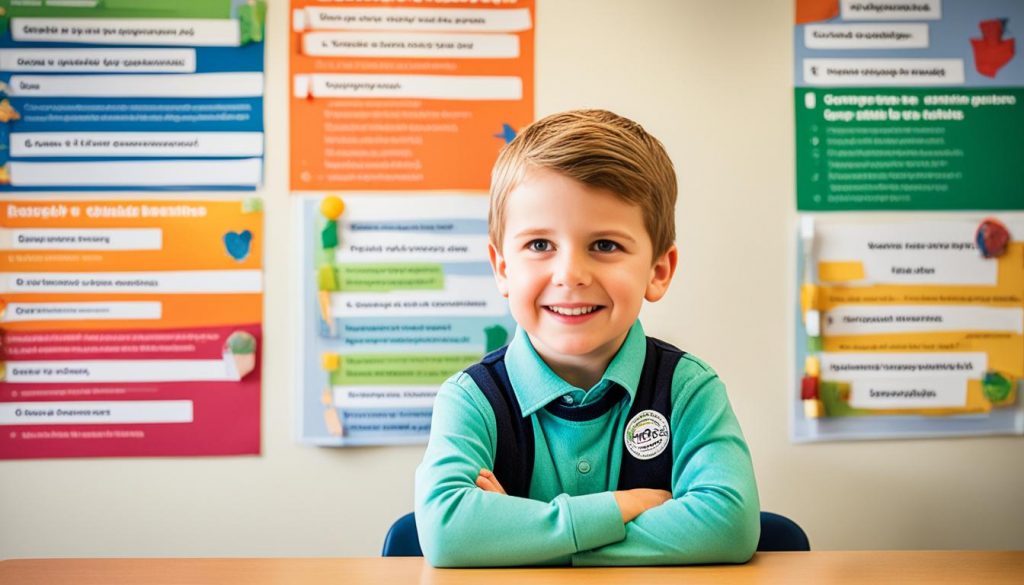When it comes to discipline, many people associate it with punishment. However, effective discipline is about more than just consequences. It is about teaching and guiding children, creating an environment of respect and learning. By implementing positive behavior management techniques and proactive discipline strategies, we can help children develop self-control, understand boundaries, and make responsible choices.
By adopting effective discipline strategies, we can create a safe and supportive learning environment for children. Instead of focusing solely on punishment, we can promote positive behavior and foster respect. Through extensive research and expert recommendations from reputable sources, we have identified a range of effective discipline strategies that align with this goal.
Key Takeaways:
- Effective discipline is about teaching and guiding children, not just punishment.
- Positive behavior management techniques promote respect and enhance learning.
- Proactive discipline strategies help children develop self-control and make responsible choices.
- Implementing effective discipline creates a safe and supportive learning environment.
- Research and expert recommendations inform the selection of these strategies.
Importance of Effective Discipline in Child Development
Effective discipline strategies are essential for promoting healthy child development. In both the classroom and home environments, these strategies help children understand boundaries, develop self-discipline, and make responsible choices. By implementing classroom behavior strategies, providing parent education on discipline, and utilizing student behavior interventions, we can create a positive learning environment that fosters academic and social growth.
Classroom behavior strategies are crucial for creating an atmosphere of respect and productivity. When teachers establish clear expectations and consistent consequences, students understand what is expected of them. By reinforcing positive behavior and addressing negative behavior promptly, teachers can effectively manage their classrooms and promote a positive learning environment.
Similarly, parents play a vital role in teaching their children discipline skills. Parent education on discipline equips parents with the knowledge and tools to establish consistent boundaries, enforce consequences, and model appropriate behavior. By providing guidance and support, parents can help their children develop self-control and make responsible choices.
Student behavior interventions are also essential for addressing individual student needs. These interventions can range from individualized behavior plans to group counseling sessions. By identifying underlying issues and providing targeted support, educators can help students overcome challenges and develop positive behavior patterns.
By implementing effective discipline strategies both at school and at home, we can nurture children’s social and emotional development while fostering a love for learning. These strategies create a supportive and respectful environment that empowers children to thrive academically and socially.
Key Components of Effective Discipline
| Component | Description |
|---|---|
| Clear expectations | Establishing clear guidelines for behavior and academic performance |
| Consistent consequences | Providing predictable and proportional consequences for behavior choices |
| Positive reinforcement | Rewarding and acknowledging positive behavior to encourage its continuation |
| Modeling | Being a positive role model for children to emulate |
| Individualized support | Providing targeted interventions and support for students with unique needs |
Key Principles of Effective Discipline
Effective discipline plays a pivotal role in shaping the behavior and character of children. It is essential to establish a disciplined approach that is based on key principles to ensure its effectiveness. In this section, we will explore the core principles that underpin effective discipline and provide specific strategies that align with these principles.
1. Affective Bond with an Adult
Effective discipline should be administered by an adult who shares an affective bond with the child, such as a teacher or parent. This bond builds trust and strengthens the relationship between the adult and the child. When discipline is delivered by a caring adult, it becomes an opportunity for teachable moments rather than a mere punitive measure.
2. Consistency is Key
Consistency is a fundamental principle of effective discipline. Children thrive in an environment where rules and consequences are consistently upheld. When expectations and consequences remain consistent, children develop a clear understanding of the boundaries, making it easier for them to make responsible choices.
3. Proximity to the Behavior
Discipline should be closely tied to the behavior needing change. This means that consequences should be immediate and directly related to the misbehavior. When children can connect their actions with immediate consequences, they develop a better understanding of cause and effect, leading to improved self-control.
4. Fairness and Perception
Discipline strategies should be perceived as fair by the child. Fairness ensures that discipline is seen as just and reasonable. When children perceive discipline as fair, they are more likely to accept the consequences and internalize the lessons learned. It is important to take into account the child’s perspective and individual circumstances when applying discipline.
5. Developmental and Temperamental Alignment
Effectiveness of discipline is greatly influenced by its alignment with the child’s developmental stage and temperament. Discipline strategies should be tailored to the child’s age, understanding, and temperament to ensure they are appropriate and effective. What works for one child may not be suitable for another, so it is crucial to consider individual differences when implementing discipline.
By adhering to these key principles of effective discipline, we can lay the foundation for positive behavior management and promote healthy development in children. In the next section, we will delve deeper into specific strategies that reflect these principles, offering practical guidance for integrating them into everyday scenarios.


Strategies for Effective Discipline
When it comes to effectively disciplining children, there are a variety of strategies that can be implemented. These strategies are designed to promote positive behavior, modify negative behavior, and provide effective consequences. By utilizing a combination of these strategies, parents and educators can create a supportive environment that encourages learning and growth.
One key strategy is setting clear expectations and consequences. When children know the expectations upfront and understand the consequences of their actions, they are more likely to make responsible choices. This can be achieved through open communication, regular reminders, and the use of visual aids such as behavior charts or goal tracking sheets.
Reinforcing positive behavior is another effective strategy. When children receive praise, recognition, or rewards for their good behavior, they are motivated to continue exhibiting positive actions. This can be accomplished through verbal praise, stickers, tokens, or privileges, depending on what works best for the individual child.
Utilizing proactive approaches is also essential. Instead of solely focusing on addressing negative behavior, proactive strategies aim to prevent misbehavior by teaching appropriate skills and providing alternative outlets for children’s emotions. This includes activities that promote self-regulation, problem-solving, and conflict resolution.
Incorporating restorative justice practices can also be beneficial. This approach focuses on repairing relationships and learning from mistakes rather than simply punishing children for their behavior. It encourages empathy, understanding, and personal growth, and can be particularly effective in resolving conflicts and building a sense of community.
Practical Tips for Implementation
Here are some practical tips for implementing these strategies:
- Establish a consistent and predictable routine to provide a sense of structure and stability.
- Communicate expectations clearly and consistently, using age-appropriate language.
- Provide immediate feedback to reinforce positive behavior.
- Use positive language when addressing behavior, focusing on what the child should do instead.
- Model the behavior you want to see by demonstrating respect, empathy, and problem-solving skills.
- Encourage children to take responsibility for their actions by involving them in the process of setting consequences.
By implementing these strategies and tailoring them to the specific needs of the child and the environment, we can effectively discipline children and promote positive behavior.
| Strategy | Benefits |
|---|---|
| Setting clear expectations and consequences |
|
| Reinforcing positive behavior |
|
| Utilizing proactive approaches |
|
| Incorporating restorative justice practices |
|
Overcoming Challenges in Implementing Effective Discipline Strategies
Implementing new discipline strategies can come with its own set of challenges. One of the main challenges is creating buy-in from stakeholders, such as teachers, parents, and administrators. When introducing new discipline strategies, it is important to communicate the benefits and rationale behind the changes. Open and transparent communication can help alleviate concerns and generate support.
Financial resources may also be a limiting factor in implementing innovative strategies. Schools and organizations may need to allocate funds to training, resources, and materials required for effective discipline implementation. Seeking funding opportunities and exploring cost-effective alternatives can help ensure the successful implementation of new strategies.
Resistance from students can pose a challenge when implementing new discipline strategies. Students may be accustomed to a different approach or may resist change due to discomfort or unfamiliarity. It is important to foster a supportive and inclusive environment where students feel heard and understood. Providing clear explanations and consequences for behavior, as well as involving students in the decision-making process, can aid in overcoming student resistance.
Strategies to Overcome Challenges:
- Effective Communication: Clearly communicate the purpose and benefits of new discipline strategies to stakeholders.
- Seek Funding Opportunities: Explore funding options and alternatives to ensure adequate resources are available.
- Foster Inclusion: Create an environment where students feel valued and involved in the discipline process.
- Provide Clear Explanations: Clearly explain the expectations and consequences associated with the new discipline strategies.
- Involve Students: Engage students in the decision-making process to address their concerns and increase ownership.
By addressing these challenges head-on and implementing strategies to overcome them, we can create a positive and effective discipline system that promotes respect and enhances learning for all students.
Conclusion
Effective discipline strategies are crucial in shaping respectful and positive behavior in children. By implementing these strategies at home and in the classroom, we, as educators and parents, can create a safe and nurturing environment that fosters learning and development.
It is important to approach discipline as a means of teaching and guiding children, rather than simply resorting to punishment. By incorporating the principles and strategies outlined in this article, we can instill important life skills in children, such as self-control, responsible decision-making, and respect for boundaries.
By setting clear expectations and utilizing proactive approaches, we can guide children towards positive behavior. Reinforcing and rewarding good behavior helps to encourage and reinforce these positive habits. Additionally, incorporating restorative justice practices can provide opportunities for reflection and growth.
Remember, effective discipline is a journey that requires patience, consistency, and open communication with children. By implementing these strategies, we can contribute to the overall well-being and growth of our children, creating a brighter future for them and for our communities.
FAQ
What is effective discipline?
Effective discipline is about teaching and guiding children rather than just forcing them to obey. It is a way to impart knowledge and skill, to set limits and instill self-control.
Why is effective discipline important in child development?
Effective discipline helps children understand boundaries, develop self-discipline, and make responsible choices. It creates a positive learning environment and encourages appropriate behavior.
What are the key principles of effective discipline?
Effective discipline should be given by an adult with an affective bond to the child, be consistent, close to the behavior needing change, and perceived as fair by the child. It should also be developmentally and temperamentally appropriate.
What are some strategies for effective discipline?
Strategies for effective discipline include setting clear expectations and consequences, reinforcing positive behavior, utilizing proactive approaches, and incorporating restorative justice practices.
What are the challenges in implementing effective discipline strategies?
Challenges in implementing effective discipline strategies include creating buy-in from stakeholders, overcoming financial limitations, and dealing with resistance from students.
How can effective discipline strategies foster respect and positive behavior?
By implementing effective discipline strategies in the classroom and at home, teachers and parents can create a safe and supportive learning environment that enhances learning and development.



